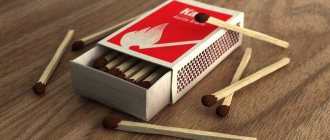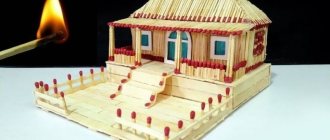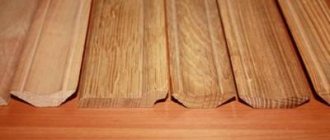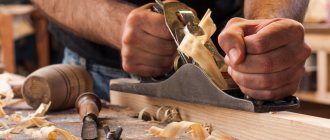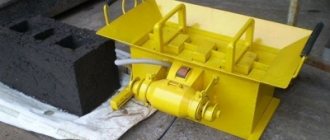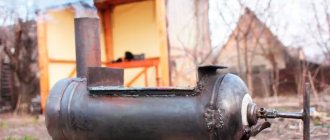The first real matches were invented on April 10, 1833, when yellow phosphorus was introduced into the mixture for match heads. This day is considered the birthday of the first match.
In Russian, the word "match" is derived from the Old Russian word "matches" - the plural form of the word "spoke" (a pointed wooden stick). Originally, this word referred to wooden nails that were used in the manufacture of shoes (to fasten the soles).
At first, the phrase “incendiary (or samogar) matches” was used to denote matches, and only after matches became widespread, the first word began to be omitted, and then completely disappeared from use.
Work of the Pobeda match factory in the village of Verkhny Lomov. Photo: RIA Novosti / Yulia Chestnova
Safety matches.
The first safety matches, ignited by friction against a specially prepared surface, were created in 1845 in Sweden, where their industrial production began in 1855 by J. Lundström. This became possible thanks to the discovery of non-toxic amorphous phosphorus by A. Schrotter (Austria) in 1844. The head of the safety matches did not contain all the substances necessary for ignition: amorphous (red) phosphorus was deposited on the wall of the matchbox. Therefore, the match could not light accidentally. The composition of the head included potassium chlorate mixed with glue, gum arabic, crushed glass and manganese dioxide. Almost all matches made in Europe and Japan are of this type.
Straw
The wood of the straw must meet several requirements:
- high porosity - provides good ability to absorb chemicals;
- rigidity - prevents the match stick from bending when it hits the surface for the purpose of ignition;
- ease of processing.
The latter property is necessary for ease of manipulation with raw materials in the manufacture of thin bars of the desired size.
Straws cut from wood veneer are impregnated with special anti-smoldering agents (phosphoric acid, diammonium phosphate), which form a film on its surface as the match burns. The wood near the head contains paraffin, which helps the flame spread efficiently. Without this component, the match would go out almost immediately after ignition.
Kitchen matches.
Matches with a double-layer head, lit on any hard surface, were patented by F. Farnham in 1888, but their industrial production began only in 1905. The head of such matches consisted of potassium chlorate, glue, rosin, pure gypsum, white and colored pigments and a small amount phosphorus. The layer at the tip of the head, which was applied with a second dipping, contained phosphorus, glue, flint, gypsum, zinc oxide and coloring matter. The matches were lit silently, and the possibility of the burning head flying off was completely excluded.
Properties: waterproof, flammable under water, wind and water resistant and more
Paraffin treatment makes hunting matches waterproof . A similar effect, but at home, can be achieved using the same paraffin or wax , applied in several layers. The products for ignition are resistant to moisture and wind , which ensures the possibility of their use in any weather. In the public domain, you can find a video that demonstrates immersing a burning match in water; as a result, it stops burning, but after removal, the burning continues. But there are specimens that demonstrate the properties declared by the manufacturers, that is, they burn under water. Resistance to moisture makes hunting matches similar to such a device as an eternal match.
Hunting matches FESKO. Photo by OZON
The characteristics may also include practicality and functionality, cost-effectiveness of use in nature, burning time, resistance to temperature and humidity changes without loss of its own properties. Despite the resistance of matches to weather influences, it is still recommended to take care of protecting the products . For this purpose, practical and convenient sealed containers are used, which will serve as protection from mechanical stress.
How to extinguish if it burns under water
Hunting matches are not that easy to put out. Therefore, for safety reasons, it is not recommended to use matches in enclosed spaces . In addition, when burned, they emit acrid smoke . Standard methods, attempts to blow out the flame, immersion in water or sand do not bring results. An effective method is to limit the access of oxygen to the match by placing it in a container with a lid. In the public domain, it is possible to find a method using bread dough, which must be rolled into a tight ball, and a burning match head is placed in it.
Match books.
Cardboard matchbooks are an American invention. The patent for them, issued to J. Pussey in 1892, was acquired in 1894. At first, such matches did not receive public recognition. But after one of the beer manufacturing companies purchased 10 million match books to advertise its products, the production of cardboard matches became big business. Nowadays, matchbooks are distributed free of charge to gain the favor of customers in hotels, restaurants, and tobacco stores. There are twenty matches in a standard book, but books of other sizes are also available. They are usually sold in packs of 50. Booklets of special design can be supplied in packages of various sizes, most suitable for the customer. These matches are the safety type, the surface for their ignition is the bottom (covered with “grey”) flap of the cover, under which the front side is tucked.
Long, as large and other types are called
The length of standard hunting matches is about 40-50 mm . But there are also large products on sale , the length of which reaches 85 mm. Large matches do not have a separate name; the difference is the size of the coating, which covers only half of the rod. While products of standard sizes are almost completely covered with an incendiary mixture. Hunting matches are packaged in cardboard boxes and plastic blisters. The second type of packaging is more preferable, as it increases the protection of products from harmful influences. The number of matches in a cardboard box is most often 20 pieces, in a blister - 6. Hunting matches differ according to the brand, color of the head and coating.
HeimHelfer Hunting matches in blister pack. Photo by OZON
Impregnation of matches.
Until 1870, fire-prevention impregnation methods were not known to prevent flameless burning of the remaining coal on an extinguished match. In 1870, the Englishman Howes received a patent for the impregnation of matches with a square cross-section. It listed a number of materials (including alum, sodium tungstate and silicate, ammonium borate and zinc sulfate) suitable for impregnating square matches by immersing them in a chemical bath.
Impregnation of round matches on a continuous match machine was considered impossible. Due to the fact that the legislation of some states since 1910 required mandatory fire impregnation, employee W. Fairbairn in 1915 proposed, as an additional operation on a match machine, immersing matches approximately 2/3 of the length in a weak solution (approx. 0.5%) of phosphate ammonium
Criterias of choice
When choosing hunting matches, it is recommended to take into account several standard criteria: cost, brand (manufacturer), length of products, number of pieces in the package. It is recommended to buy matches in sealed packaging , which provides protection from external influences. It is first necessary to check the quality of hunting matches: do they burn under water and after getting wet? Do they light up in strong winds? It is important to remember that there are a large number of low-quality products on sale, so it is recommended to purchase matches from trusted suppliers or directly from manufacturers.
Hunting matches Survival 43 mm. (does not go out in water). Photo by OZON
Phosphorus sesquisulfide.
White phosphorus, used to make matches, caused bone disease, tooth loss, and necrosis of jaw areas among match factory workers. In 1906, an international agreement was signed in Bern (Switzerland) prohibiting the manufacture, import and sale of matches containing white phosphorus. In response to this ban, harmless matches containing amorphous (red) phosphorus were developed in Europe. Phosphorus sesquisulfide was first obtained in 1864 by the Frenchman J. Lemoine, mixing four parts of phosphorus with three parts of sulfur without access to air. In such a mixture, the toxic properties of white phosphorus did not appear. In 1898, French chemists A. Seren and E. Cahen proposed a method of using phosphorus sesquisulfide in match production, which was soon adopted in some European countries.
In 1900 she acquired the right to use a patent for matches with phosphorus sesquisulfide. But the patent claims were intended for matches with a simple head. The quality of sesquisulfide matches with a two-layer head turned out to be unsatisfactory.
In December 1910, W. Fairbairn developed a new formula for harmless matches with phosphorus sesquisulfide. The company published the patent claim and allowed all competitors to use it for free. A law was passed placing a two-cent tax on every box of white phosphorus matches, and white phosphorus matches were forced out of the market.
Production Line
A plant for the production of these products must have at its disposal several main machines, such as:
- application of phosphorus;
- creating boxes;
- mixing chemical elements;
— automatic continuous equipment for the production of matches;
— selecting device;
- Dryer;
- cutting unit.
The entrepreneur already purchases any other minor devices at his individual request. All specified equipment for the production of matches will cost on average from 19 to 23 million rubles. Although you can reduce costs if you remove the steps for producing straws (you just buy them). And of course, the production of matches and their storage requires special premises in which all fire safety standards will be strictly observed.
Production of wooden matches.
Modern wooden matches are made in two ways. With the veneer method (for matches with a square cross-section), selected aspen logs are sanded and then cut into short logs, which are peeled or planed into strips corresponding in width to the length of the matches, one match thick. The ribbons are fed into a match machine, which cuts them into individual matches. The latter are mechanically inserted into the perforations of the plates of the machine for applying heads by dipping. In another method (for round matches), small pine blocks are fed into the head of the machine, where die-cutting dies arranged in a row cut out the match blanks and push them into the perforations of metal plates on an endless chain.
In both production methods, matches pass sequentially through five baths in which a general impregnation with a fire-fighting solution is carried out, a ground layer of paraffin is applied to one end of the match to ignite the wood from the match head, a layer forming the head is applied on top of it, a second layer is applied to the tip of the head and then Finally, the head is sprayed with a strengthening solution that protects it from atmospheric influences. After passing on an endless chain through huge drying drums for 60 minutes, the finished matches are pushed out of the plates and enter a filling machine that distributes them into matchboxes. The wrapper then wraps three, six, or ten boxes in paper, and the packaging machine fills them into shipping containers. A modern match machine (18 m long and 7.5 m high) produces up to 10 million matches in an 8-hour shift.
Main varieties
These products are divided depending on the material from which they are made, into:
- wooden (made from soft wood - linden, aspen);
- wax;
- cardboard.
Based on the type of ignition, the following types of matches are distinguished:
- Grating. This type is lit on a special surface called a “grater.” Today in Russia they are the most common matches. Their production accounts for 99% of all manufactured matches.
- Besterless. They ignite by friction against any surface.
Production of cardboard matches.
Cardboard matches are made on similar machines, but in two separate operations. Pre-treated cardboard from large rolls is fed into a machine that cuts it into “combs” of 60–100 matches and inserts them into the nests of an endless chain. The chain carries them through the paraffin bath and the head forming bath. The finished combs go into another machine, which cuts them into double “pages” of 10 matches and seals them with a pre-printed lid equipped with a strike strip. The finished matchbooks are sent to the filling and packaging machine.
Storage conditions
Hunting matches are an essential element of survival; they may be needed at any time, so they need to be stored in an emergency kit located on the body. The main requirements for an emergency kit are miniaturization and inconspicuousness , so an excellent solution is a sealed container that can be placed around the neck or fastened to trousers or put in a pocket. Matches packed in a blister do not need additional protection. But after opening the blister, it is also possible to use alternative methods and means for cardboard boxes. They can be placed in a bag with a reliable and convenient zip-lock fastener.
Impregnation with paraffin will keep matches in working condition, even if they get wet. It is necessary to impregnate both the head and the rod. To do this, you need to melt the paraffin in a metal bowl in a water bath to prevent the paraffin from evaporating. It is recommended to immerse matches in paraffin using tweezers, which ensures an even coating. Drying of coated matches is done on newspaper. Before ignition, paraffin must be removed and cleaned from the head. Effective protection against moisture is shown by coating with varnish : nail or furniture. Scotch tape is used on hikes as a universal repair tool. It is possible to make a kind of envelope from adhesive tape and place several matches there. To prevent the edges from peeling off, it is recommended to melt the tape to obtain a secure seam.
Advice
When producing matches, it is necessary to monitor the condition of the equipment used (keep it clean), and the premises should also be cleaned (twice a day). The sewer well is equipped with a sump. It must be cleaned after cleaning.
The rules state that the transportation of incendiary mass through the coating department, drying machines, and warehouses for these products is strictly prohibited, as is the transfer of phosphorus mass through equipped premises. Preparing machines for work and repairing them must be done on the condition that there are no matches in them. The clothing of plant workers must be impregnated with a fire retardant solution.

